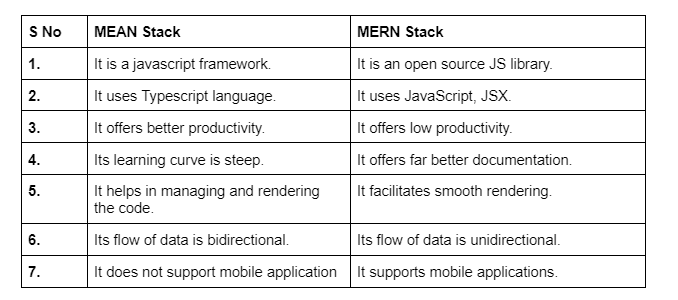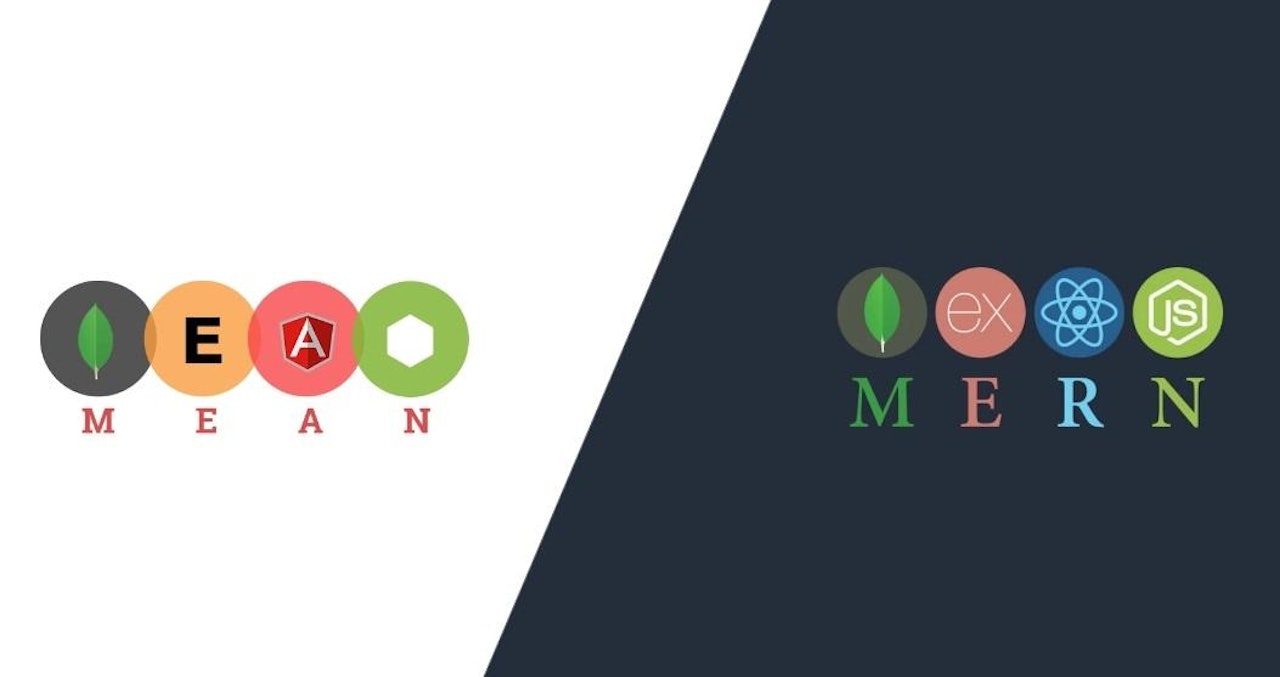If you’re looking to learn how to develop applications using JavaScript, you’ve probably heard of two acronyms that are often used in this space - MEAN and MERN. The acronyms stand for MongoDB, ExpressJS, AngularJS, and Node.js and MongoDB, ExpressJS, ReactJS, and Node.js respectively, but what exactly do they mean?
The Mean vs MERN Stack showdown pits two of the most common web development stacks against each other in an all-out war over which one will reign supreme and be crowned champion. Which stack will come out on top? Read on to find out!
About MEAN Stack
The MEAN Stack refers to the use of MongoDB, ExpressJS, AngularJS, and NodeJS to build web applications or software. While each of these tools on their own offer powerful capabilities, when combined they create an effective and easy-to-use web development platform that allows you to build full stack web applications in no time at all.
While the MEAN stack is still growing in popularity, it’s already used to power some large applications with high load rates and huge amounts of traffic.
The concept of MEAN was coined by Valeri Karpov in his 2013 blog post, The Mean Stack; since then, it has been increasingly popular among technology companies around the world. Some of its benefits include its ability to incorporate existing technology (e.g., REST APIs), its flexibility, its open source nature and versatility with cloud-based solutions such as Amazon Web Services.
These components make it easier than ever before for both experienced developers and entry-level developers alike to build software quickly while still maintaining a high level of quality. MEAN Development provides a complete environment for web application development.
This is not just another framework or an alternate stack, it is an out-of-the-box solution with features and benefits that enable you to get your project done in a short period of time.
About MERN Stack
The MERN stack, which stands for MongoDB, Express, React and Node, has become the most popular way to rapidly develop applications using Node. The MERN Stack is a collection of development tools that are quickly becoming the industry standard in modern web application development.
With the MERN Stack, developers can work with MongoDB and Express to quickly build scalable web applications with the added benefit of being able to use ReactJS on their front end.
 View Website
View Website
 View Website
View Website
 View Website
View Website
MERN is a great stack for building web applications. Like all software development projects, you’ll encounter some pros and cons along your way. There are a few key benefits of MERN development over other frameworks like Laravel or Ruby on Rails.
- First, MERN applications can run on any operating system with node installed (Linux/MacOS/Windows).
- Second, MERN applications are usually just as fast as Angular 2 or React apps since they're built off of NodeJs which allows for full server-side rendering and non-blocking IO.
- Finally, MERN provides a great deal of flexibility because it combines 3 different frameworks into one package making it easier to use each framework individually in future projects if necessary.
About Associated Technologies
Before we get started with the guide, let’s briefly discuss each of the four technologies that make up the MEAN & MERN stack.
Node.js Overview
Node.js is a framework for building fast, scalable network applications. It uses an event-driven, non-blocking I/O model that makes it lightweight and efficient, perfect for data-intensive real-time applications that run across distributed devices.
Node.js uses Chrome's V8 runtime engine to execute code within web browsers without the need for any plugins; making Node.js scripts run equally well in both environments.
The framework is designed with a simple API meant to be easy to learn and use while offering maximum flexibility, scalability and performance under heavy load on both client and server machines.
AngularJS Overview
AngularJS is a popular, modern framework for building web applications that also enables developers to write Single Page Applications (SPAs). AngularJS is completely open source, which makes it a great candidate for freelancers or startups who want access to cutting-edge technology without having to commit large amounts of capital.
One of AngularJS’s greatest strengths is its ease of use. While developers need some JavaScript experience, it’s much more approachable than many other frameworks. This has led people with very limited development experience being able to contribute code and collaborate on projects.
To get an in-depth understanding of how to build applications using AngularJS we should look at all levels of it as well as how different parts work together and also discuss some best practices.
MongoDB Overview
You probably didn’t realize it, but you’ve been using NoSQL databases before. (Check out how cloud infrastructure from any provider stacks up here.) Most websites today are powered by a relational database management system (RDBMS) like MySQL or PostgreSQL.
But that doesn’t mean they can’t benefit from another kind of database—one that uses non-relational data structures and doesn’t require a fixed schema. Enter MongoDB. This NoSQL database uses something called a document store, which separates data into individual documents that aren't strongly coupled to each other.
ExpressJS Overview
ExpressJS is a web framework for Node.js, which lets you create a server side website using only JavaScript. Before using ExpressJS, you’ll need to have Node installed on your computer—but it’s very easy and free to do.
Once you’ve downloaded Node and are ready to code, you can use NPM (Node Package Manager) to install ExpressJS itself. This will give you access to all of its features right away; by requiring express in your main JavaScript file, it will also be available in any other files loaded after that.
React Overview
React is an open-source JavaScript library, maintained by Facebook and a community of individual developers and corporations. React was developed in 2013 by Jordan Walke, a software engineer at Facebook, who had worked on infrastructure for their news feed.
According to Frontend Masters, React is often characterized as being a ‘Virtual DOM + event system’ because it relies upon a virtual representation of a user interface (UI) and uses events for updating that UI from within user-defined components.
In simpler terms, React gives you flexibility over how you create your views/pages which makes it suitable for almost any type of application development – be it desktop or mobile application.
How Do You Decide Which One to Choose?
This is a common question, because both are established front-end frameworks and have been around for years. Both do similar things, although MEAN has a more monolithic style to it whereas MERN is component based. There are a few factors that influence which one to choose, including (but not limited to) development experience, personal preference, and project size.
When deciding which one to choose, you must be aware of your needs. Both are powerful and popular choices, but both have trade-offs that may or may not work for you. For example, MEAN runs on MongoDB, so if you’re already heavily invested in SQL-type databases then choosing MERN might not make sense.
It’s also worth noting that Laravel is technically a framework within MERN—it provides a lot of structure and configuration out of the box, so it might be less flexible if you want more control over configuration options.

Conclusion
Now that you’ve learned about both MEAN and MERN development stacks, it’s up to you to determine which one is better for your business. Ultimately, it’s about selecting a stack that matches your needs and aligns with your goals.
While there are pros and cons to each, it’s hard to deny that MEAN development is more efficient in many cases. All of these frameworks have excellent tools for building dynamic websites, and regardless of your choice you’ll be up and running quickly on a strong foundation for fast, robust growth.
Whether you go to hire MEAN stack developers or hire MERN stack developers, you can expect awesome support from us! Our team will work with your current resources, or we can provide full-service development. To start a discussion about which development stack is best for you, contact us today!


Comments (0)